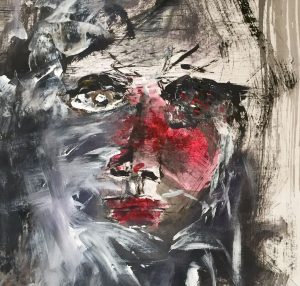Wiped Out

The digital image of an abstract self-portrait in 3/4 view. The portrait is in extreme close-up painted to the margins and fills the page. A face framed by long hair, the portrait is painted loosely in a series of multi-directional black and white brushstrokes and swipes applied with vigour. The face is slightly turned to the right side and inclined, eye in the same direction.
The mid-right center of the face is dominated by carmine red. Washes of diluted carmine red acrylic paint over the nose bridge, the right cheek, the right eye and the lips. The mark making is dynamic and without order. The right eye is completely covered with black and red marks.
To the left side of the painting white acrylic paint is laid on more textured and blurred horizontally and vertically into the hair, one large white swish covers part of the chin. These marks in combination are partially erasing and covering the woman’s face.
The left eye of the woman is wide open, sclera painted in thick titanium white acrylic with a hazel rim indicating the iris. This stands in contrast to bloodshot appearance of the right eye and draws the viewer into the gaze of the woman.
This autobiographic piece depicts the emotions on the height of an autoimmune lupus flare. In this self-portrait, the fire red nose bridge and cheeks seem to demand the immediate attention of the viewer.
Here the inflamed eyes—one still visibly hazel, one bloodshot—seem to be staring into a void. Both numbed by the struggle and in stark contrast to the boldly blurred mark making around the face. It is these blurred lines which put emphasis on the eradication of identity—eradication of the artist who suffers from herself and eradication from society. As the title states here, she is “Wiped Out” in the truest sense.
Illness is shown as violence committed by self, in self, against self. Illness asks no consent, knows no border, respects no boundary. The limited palette of colours—black, white, and red—are literally thrown in the face of the viewer as a representation of the artist’s fright, flight, and—ultimately—fight.
Or, is it the ‘freeze: we are? That moment in time when the patient accepts and undergoes, numbing out until the flare has passed.
This piece invites, puzzles and confronts the onlooker, it may even shock all its rawness.
And yet there is a bright fire burning in this fight of visceral presence. The full red lips signal life. The hazel eye, wide-open, is alert and observes. Ready to move again and live another day.
Back to Top of Page | Back to Art | Back to Volume 15, Issue 2 – Summer 2021
About the Artist
Martina Peschen has lived and worked across the globe from Europe to South America and is a true polyglot, speaking seven languages. Ireland is now her home; she lives on the West Coast of Ireland on Achill, part of the Wild Atlantic Way, an area known for its rugged, windswept beauty. In her work, Martina draws widely from a broad creative background (multimedia, photography, film, painting), her cross cultural experiences, and living with the debilitating, rare, progressive autoimmune condition, PBC (Primary Biliary Cholangitis). This condition comes with a number of other overlapping autoimmune conditions, such as Lupus and Sjögren Syndrome. She describes her literary work as ‘”painting with words.” In this descriptive style, she has the ability to transmit a full gamut of sensory experience through atmospheric poetry and short stories which are often accompanied with her visual art. Using a multidisciplinary approach, she has found a freedom to express the reality of her own existence, without filter. Since 2016, Martina has been participating annually in the University of Iowa’s MOOC writing programs. Several of her poems have been published in the literary magazine, The Galway Review.